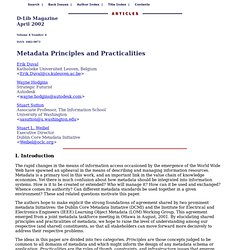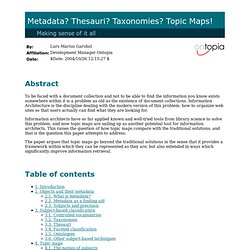

Metadata Principles and Practicalities. I.

Introduction The rapid changes in the means of information access occasioned by the emergence of the World Wide Web have spawned an upheaval in the means of describing and managing information resources. Metadata is a primary tool in this work, and an important link in the value chain of knowledge economies. Yet there is much confusion about how metadata should be integrated into information systems. How is it to be created or extended? The authors hope to make explicit the strong foundations of agreement shared by two prominent metadata Initiatives: the Dublin Core Metadata Initiative (DCMI) and the Institute for Electrical and Electronics Engineers (IEEE) Learning Object Metadata (LOM) Working Group.
The ideas in this paper are divided into two categories. II. A. Metadata modularity is a key organizing principle for environments characterized by vastly diverse sources of content, styles of content management, and approaches to resource description. B. C. D. How To Use HTML Meta Tags - Search Engine Watch (SEW) Want top search engine rankings?

Just add meta tags and your website will magically rise to the top, right? Wrong. Meta tags are one piece in a large algorithmic puzzle that major search engines look at when deciding which results are relevant to show users who have typed in a search query. While there is still some debate about which meta tags remain useful and important to search engines, meta tags definitely aren't a magic solution to gaining rankings in Google, Bing, Yahoo, or elsewhere – so let's kill that myth right at the outset. However, meta tags help tell search engines and users what your site is about, and when meta tags are implemented incorrectly, the negative impact can be substantial and heartbreaking. Using Dublin Core. NOTE: This text was last revised in 2005.

As of 2011, a completely revised User Guide is being developed at the wiki page DCMI's Glossary and FAQ are also under revision. Table of Contents 1. Introduction 2. 3. 1. 1.1. Metadata has been with us since the first librarian made a list of the items on a shelf of handwritten scrolls. A metadata record consists of a set of attributes, or elements, necessary to describe the resource in question. Metadata Thesauri Taxonomies Topic Maps! Making sense of it all Abstract To be faced with a document collection and not to be able to find the information you know exists somewhere within it is a problem as old as the existence of document collections.

Information Architecture is the discipline dealing with the modern version of this problem: how to organize web sites so that users actually can find what they are looking for. Information architects have so far applied known and well-tried tools from library science to solve this problem, and now topic maps are sailing up as another potential tool for information architects. This raises the question of how topic maps compare with the traditional solutions, and that is the question this paper attempts to address. The paper argues that topic maps go beyond the traditional solutions in the sense that it provides a framework within which they can be represented as they are, but also extended in ways which significantly improve information retrieval.
Table of contents 1. 2. Categories, Links, and Tags. Ontology is Overrated: Categories, Links, and Tags This piece is based on two talks I gave in the spring of 2005 -- one at the O'Reilly ETech conference in March, entitled "Ontology Is Overrated", and one at the IMCExpo in April entitled "Folksonomies & Tags: The rise of user-developed classification.

" The written version is a heavily edited concatenation of those two talks. Today I want to talk about categorization, and I want to convince you that a lot of what we think we know about categorization is wrong. In particular, I want to convince you that many of the ways we're attempting to apply categorization to the electronic world are actually a bad fit, because we've adopted habits of mind that are left over from earlier strategies. I also want to convince you that what we're seeing when we see the Web is actually a radical break with previous categorization strategies, rather than an extension of them.
Protege. How to Make a Faceted Classification and Put It On the Web. Update February 2011: This has been translated into Dutch: Hoe maak je een facetclassificatie en hoe plaats je haar op het web?

Many thanks to Janette Shew and the Information Architecture Institute's Translations Initiative for doing this. Also, How to Reuse a Faceted Classification and Put It On the Semantic Web, by Bene Rodriguez-Castro, Hugh Glaser and Les Carr, takes my example of dishwashing detergents and extends it into ontologies and RDF. Update February 2007: IA Voice has used this paper as the basis for a series of four podcast episodes! It starts with IA E-Learning: Faceted Classification (1 of 4).
Denton, William. This follows Putting Facets on the Web: An Annotated Bibliography, and is the second paper I wrote for Prof. 0. Faceted classifications are increasingly common on the World Wide Web, especially on commercial web sites (Adkisson 2003). What are facets? Metadata? Thesauri? Taxonomies? Topic Maps!